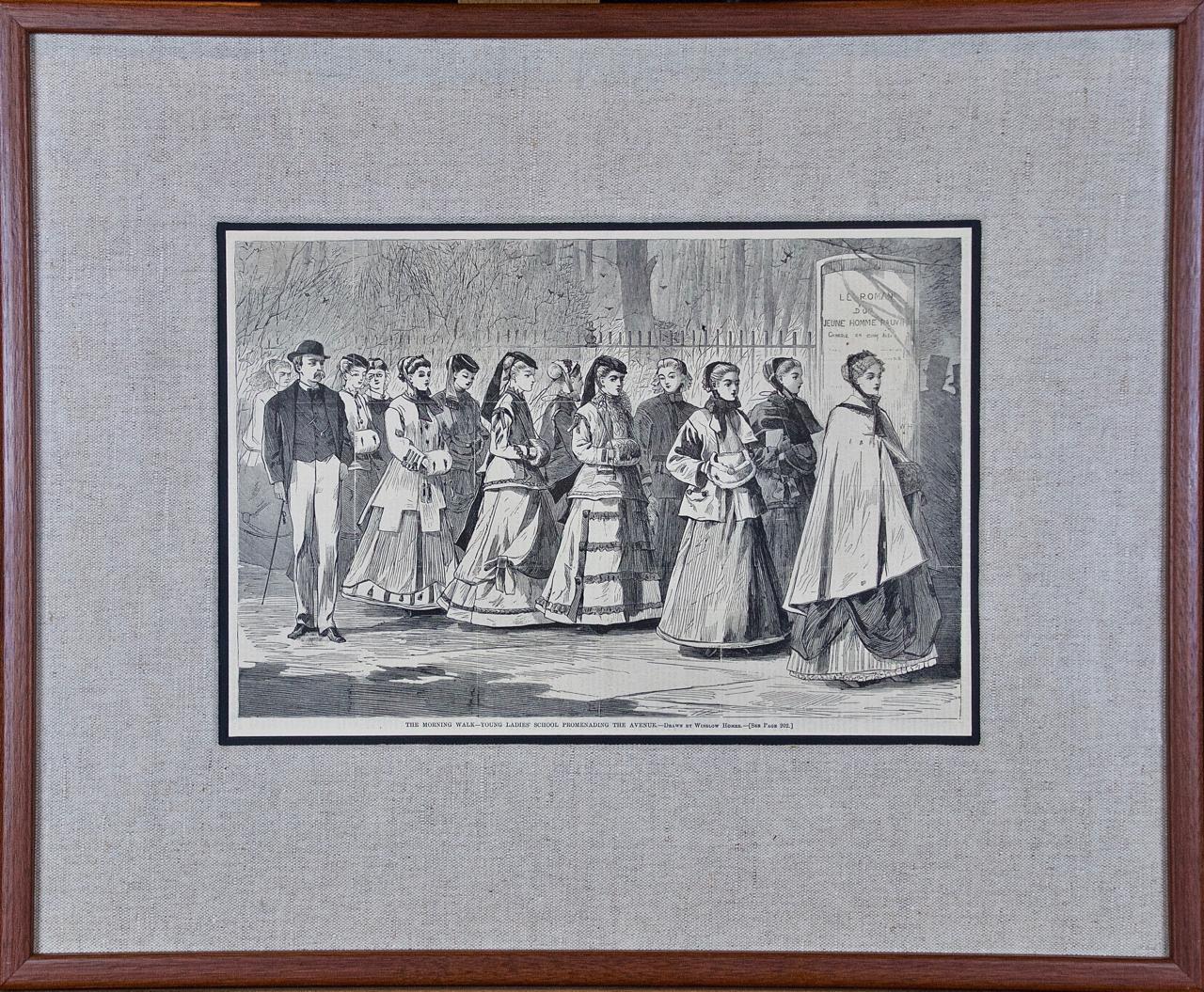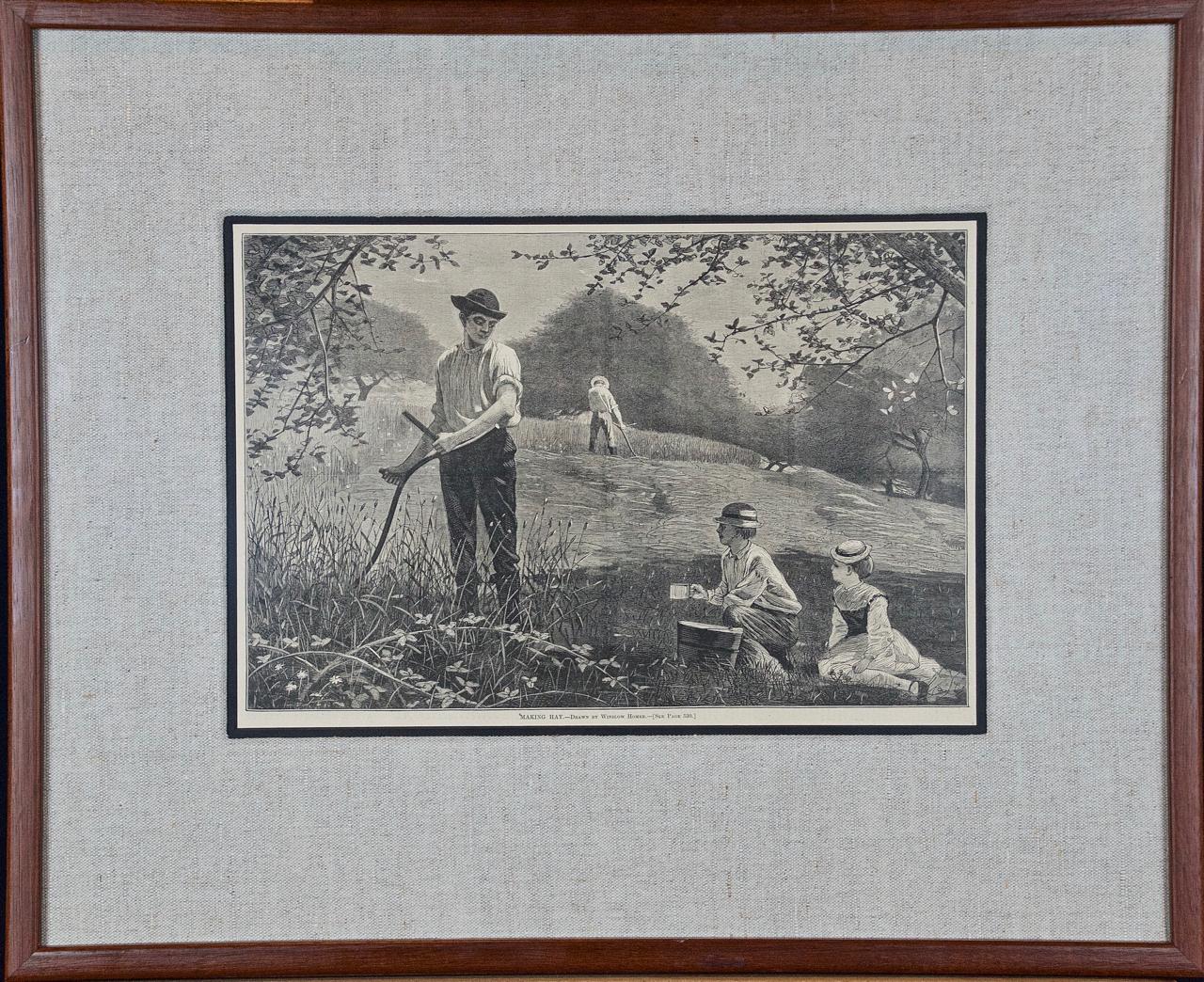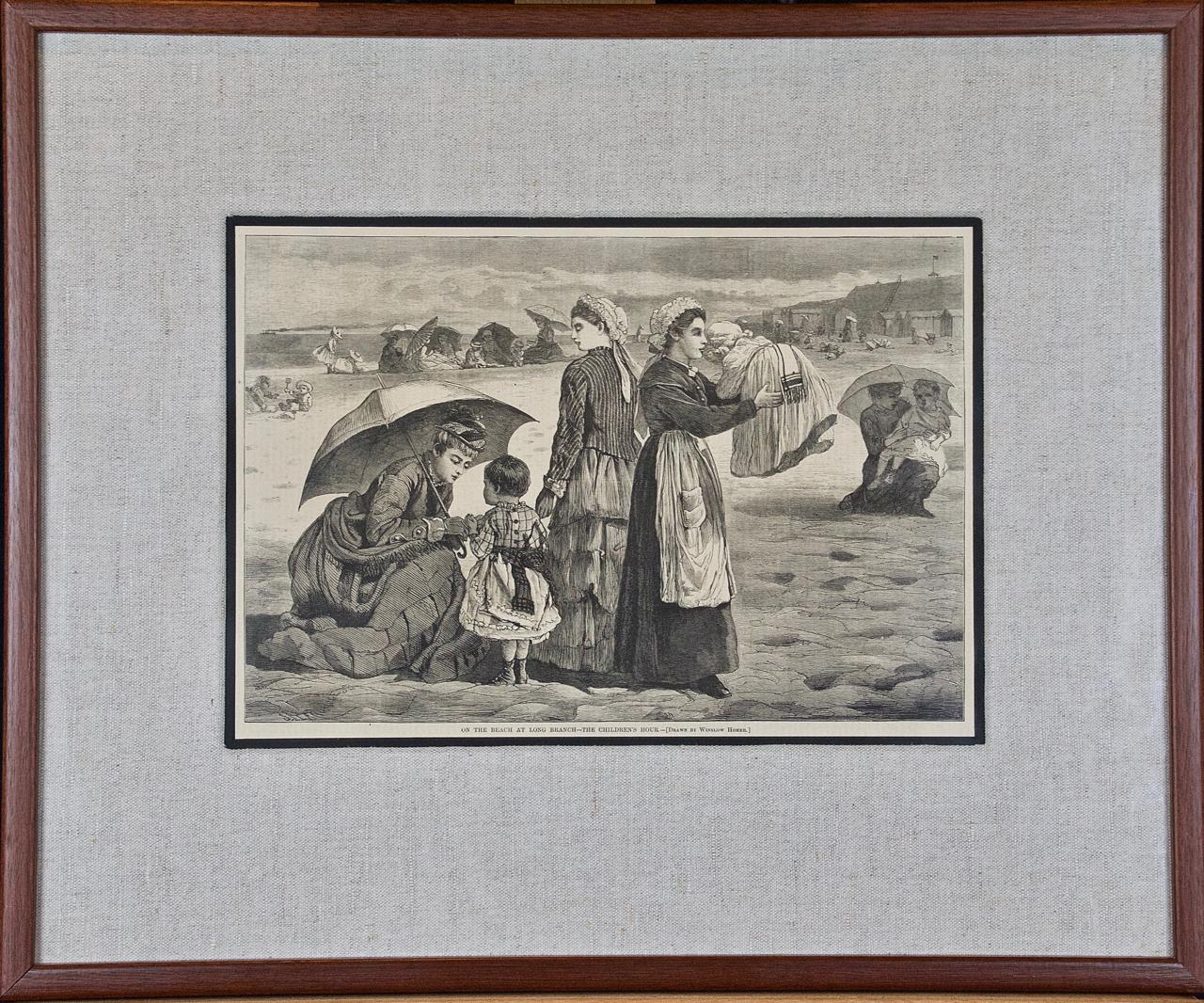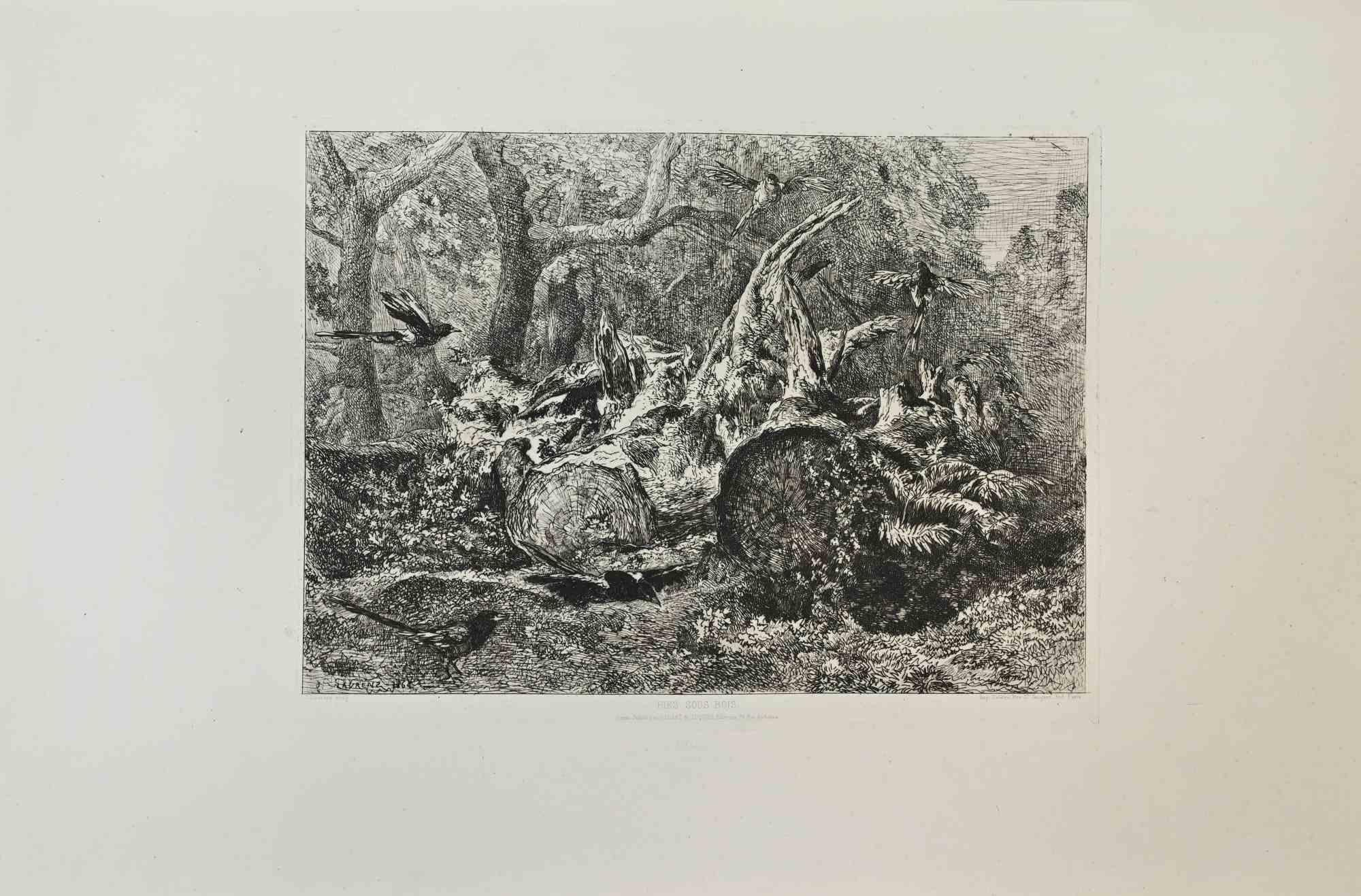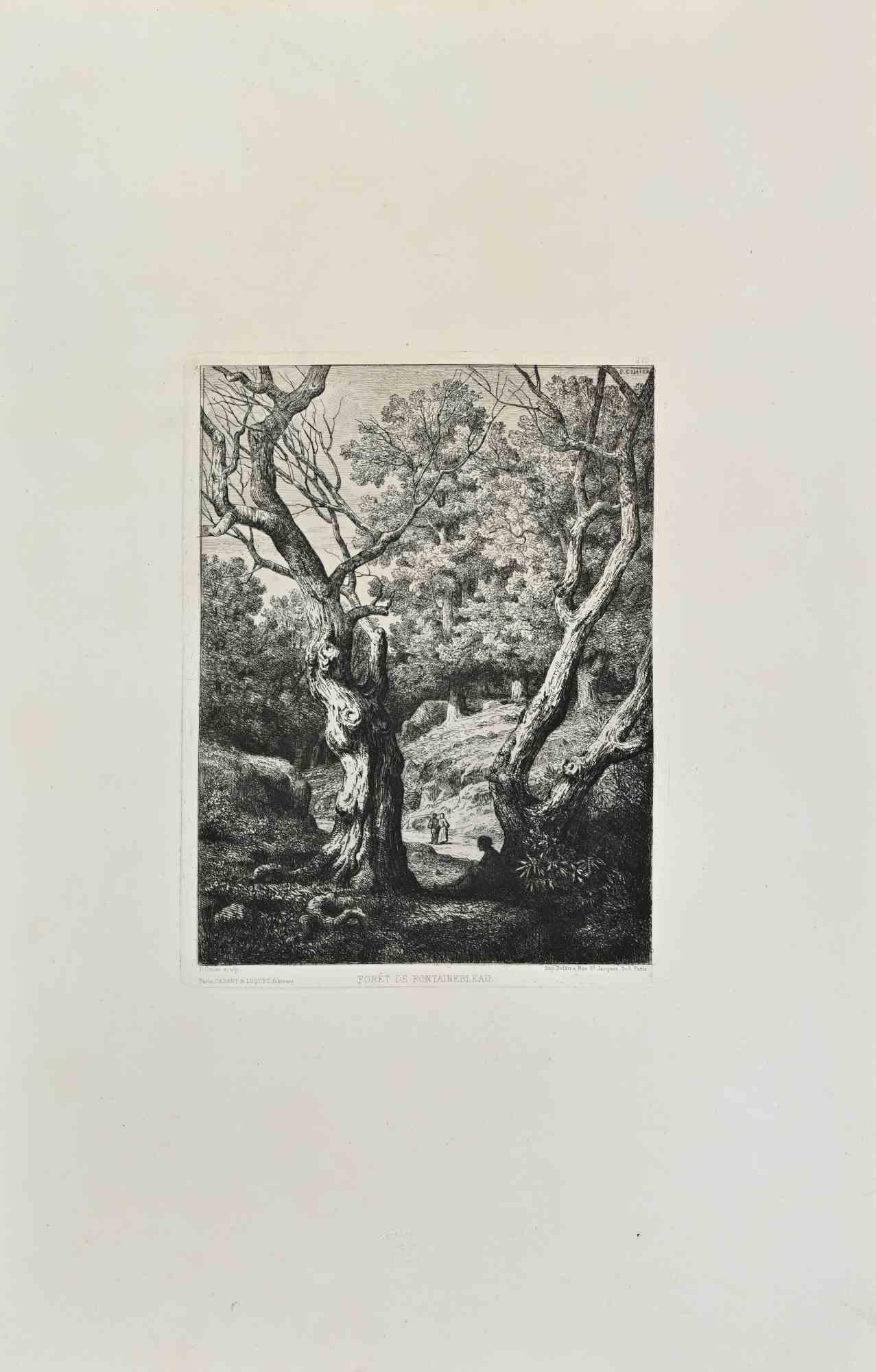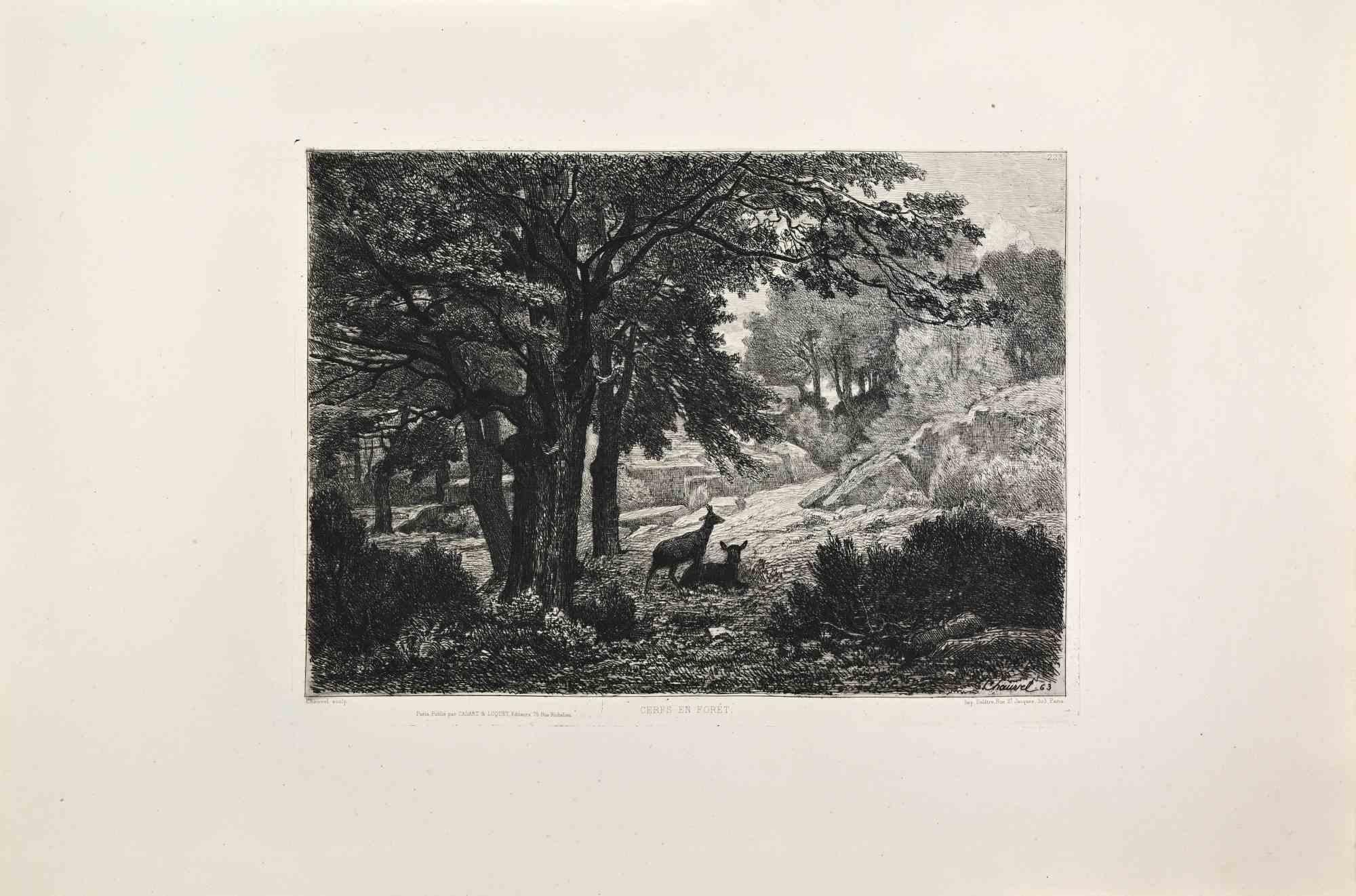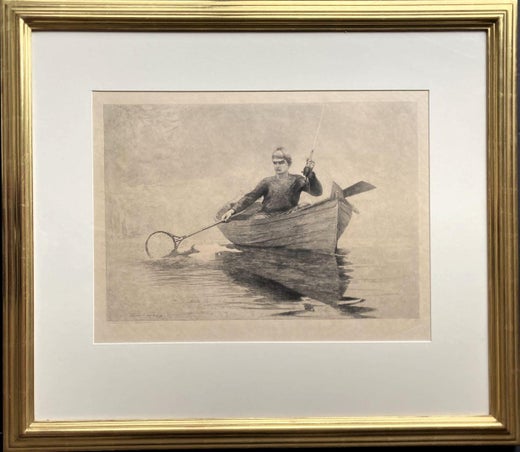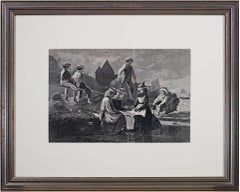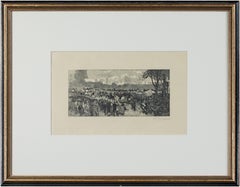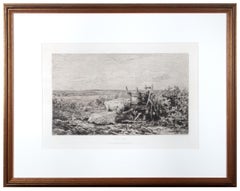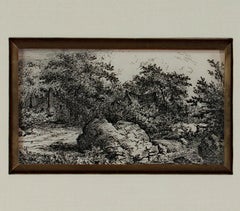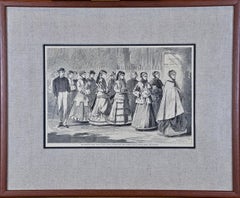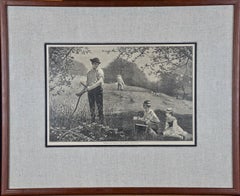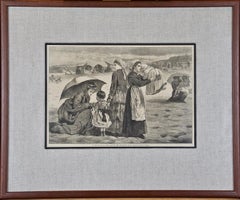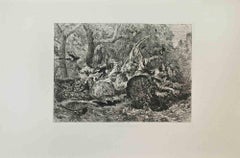Items Similar to 19th century woodcut engraving print figurative American forest trees scene
Want more images or videos?
Request additional images or videos from the seller
1 of 8
Winslow Homer19th century woodcut engraving print figurative American forest trees scene1859
1859
$2,450
£1,909.03
€2,165.73
CA$3,521.20
A$3,877.18
CHF 2,010.49
MX$45,916.48
NOK 25,521.86
SEK 23,853.07
DKK 16,175.44
About the Item
The present woodcut engraving is an original print designed by Winslow Homer, originally published in Harper's Weekly on April 30, 1859. It is an excellent example of the many prints Homer produced of fashionable people engaged in leisurely activities, in this case along a picturesque countryside lane. The sign reading 'Belmont' on the left indicates this is probably near his home in Belmont Massachusetts. The image presents multiple figures, both men and women, riding horseback: Some in the distance gallop away, toward a town marked by a church steeple beyond. Three others in the foreground, including two equestrian women, gather around a group of children who have been gathering flowers and trapping birds. Another of the children holds a pole with a May Day wreath at its top. The print thus not only celebrates the holiday, but also modern life and the modern woman.
9.5 x 13.75 inches, artwork
18.50 x 23.25 inches, frame
Entitled "May Day in the Country" bottom center (covered by matting)
Framed to conservation standards using archival materials including 100 percent rag matting, museum glass, and housed in a toned silver gilt moulding
In excellent condition; some minor toning to paper
Winslow Homer (February 24, 1836 – September 29, 1910) was an American landscape painter and printmaker, best known for his marine subjects. He is considered one of the foremost painters in 19th-century America and a preeminent figure in American art.
Largely self-taught, Homer began his career working as a commercial illustrator. He subsequently took up oil painting and produced major studio works characterized by the weight and density he exploited from the medium. He also worked extensively in watercolor, creating a fluid and prolific oeuvre, primarily chronicling his working vacations.
Homer's career as an illustrator lasted nearly twenty years. He contributed illustrations of Boston life and rural New England life to magazines such as Ballou's Pictorial and Harper's Weekly at a time when the market for illustrations was growing rapidly and fads and fashions were changing quickly. His early works, mostly commercial engravings of urban and country social scenes, are characterized by clean outlines, simplified forms, dramatic contrast of light and dark, and lively figure groupings — qualities that remained important throughout his career. His quick success was mostly due to this strong understanding of graphic design and also to the adaptability of his designs to wood engraving.
- Creator:Winslow Homer (1836 - 1910, American)
- Creation Year:1859
- Dimensions:Height: 18.5 in (46.99 cm)Width: 23.25 in (59.06 cm)
- Medium:
- Movement & Style:
- Period:
- Condition:In excellent condition. Some minor toning to paper. Housed in new frame.
- Gallery Location:Milwaukee, WI
- Reference Number:Seller: 8567g1stDibs: LU60536116702
Winslow Homer
Winslow Homer (1836-1910) was an American landscape painter, printmaker and publication illustrator. He is considered one of the most important American artists of the 19th-century. Largely self-taught Homer initially worked as an illustrator for various publications, including: Harper's Weekly, Frank Leslie's Illustrated Newspaper and Ballou's Pictorial Magazine. He worked for Harper's during the Civil War, producing woodcut engravings depicting the personal experiences of soldiers. He later became a master of oil and watercolor painting, often focussing on maritime themes. Harper’s Weekly, published in New York, was an extremely popular publication in the nineteenth and early twentieth centuries. In weekly issues Harper’s reported the news, entertained with literature, poetry and art, as well as educating its readers about world affairs and new inventions. It's woodcut engraved illustrations and literature added to its popularity, employing major artists and authors of the time, including Winslow Homer, Charles Dickens, William Makepeace Thackeray and Thomas Nast.
About the Seller
4.9
Gold Seller
Premium sellers maintaining a 4.3+ rating and 24-hour response times
Established in 1966
1stDibs seller since 2017
452 sales on 1stDibs
Typical response time: 1 hour
- ShippingRetrieving quote...Shipping from: Milwaukee, WI
- Return Policy
More From This Seller
View All19th century engraving figurative landscape Victorian urban city scene signed
By Winslow Homer
Located in Milwaukee, WI
"SEESAW--Gloucester, Massachusetts" is an original wood engraving after Winslow Homer. The artist initialed the piece in the lower right. This print depicts six children on a seesaw ...
Category
1870s Academic Figurative Prints
Materials
Engraving
'Hyde Park' original woodcut engraving signed by Auguste Louis Lepère
By Auguste Louis Lepère
Located in Milwaukee, WI
The present artwork is an excellent example of the woodcut engravings of Auguste-Louis Lepère (1849 - 1918). He was the son of the sculptor Francois Lepère, a...
Category
1860s Realist Figurative Prints
Materials
Woodcut, Engraving
19th century landscape etching farm field black and white figures pastoral scene
By Charles François Daubigny
Located in Milwaukee, WI
Charles Francois Daubigny's etching from around 1865 is an example of the Barbizon painters' preoccupations. Entitled "Les Vendages," the work depicts peasants bringing in the harves...
Category
Mid-19th Century Barbizon School Landscape Prints
Materials
Etching
18th century landscape etching pastoral house nature scene detailed ink trees
By John Thomas Smith
Located in Milwaukee, WI
"Figure by the Cottage in Forest" is an original etching by John Thomas Smith. The miniature landscape shows a pair of cottages in the woods, nestled back into the trees. A river flo...
Category
1790s Old Masters Landscape Prints
Materials
Paper, Ink, Etching
18th century landscape etching pastoral house nature scene detailed ink trees
By John Thomas Smith
Located in Milwaukee, WI
"English Country Fisherman by the Cottage" is an original etching by John Thomas Smith. The miniature etching features a country cottage with a thatc...
Category
1790s Old Masters Landscape Prints
Materials
Paper, Ink, Etching
17th century etching black and white landscape scene forest trees figures sky
By Claude Lorrain
Located in Milwaukee, WI
"Le Temps, Apollon, et les Saisons (Time, Apollo, and the Seasons)" is an etching by Claude Gellée (Le Lorrain). This etching is the Fifth state (A). This state is also in collections in Paris (BN, L, PP) and Washington; Mannocci cat. no. 43. The inscription reads: "Apollo in atto di obedire al tempo. La Primavera a cominciare il ballo. Lestate no manca del suo calore. L'aurunno colsuo licore / Seguita. Linvernno tiene la sua staggione, Claudio Gillee inven.Fec.Roma 1662 con licenza de super."
A powerful example of Claude's staging of landscape in the classical manner is the etching "Time,
Apollo, and the Seasons," done in 1662 after Poussin's painting of 1624-1636, "Dance to the Music of Time...
Category
Mid-17th Century Old Masters Landscape Prints
Materials
Etching
You May Also Like
Winslow Homer 19th Century Woodcut Engraving "The Morning Walk"
By Winslow Homer
Located in Alamo, CA
This Winslow Homer woodcut engraving entitled "The Morning Walk, Young Ladies' School Promenading the Avenue", was published in Harper's Weekly in the...
Category
1870s American Impressionist Landscape Prints
Materials
Engraving, Woodcut
$700 Sale Price
20% Off
Winslow Homer 19th Century Woodcut Engraving "Making Hay"
By Winslow Homer
Located in Alamo, CA
This Winslow Homer woodcut engraving entitled "Making Hay", was published in Harper's Weekly in the July 6, 1872 edition. It depicts a two men hand cutting high grass on a hill. The man in the foreground is looking at a young boy and a girl (presumably his children), who are sitting on the ground with a picnic basket.
This beautiful Homer woodcut engraving is presented in a brown wood frame and a light beige fabric mat with a black inner mat. The print is in excellent condition.
There are two other Homer woodcut engravings in identical frames and mats that are listed on 1stdibs. See LU117326148332 and LU117326148272. These would make a wonderful display grouping. A discount is available for the purchase of two or all three of these prints.
This Winslow Homer engraving...
Category
1870s American Impressionist Landscape Prints
Materials
Engraving, Woodcut
$700 Sale Price
20% Off
Winslow Homer Framed Original 19th Century Wood Engraving "On the Beach"
By Winslow Homer
Located in Alamo, CA
This Winslow Homer wood engraving entitled "On the Beach at Long Branch, The Children's Hour", was published in Harper's Weekly in the August 15, 1874 ed...
Category
1770s American Impressionist Landscape Prints
Materials
Engraving
$780 Sale Price
20% Off
Pies Sous Bois - Etching by Jules Laurens - 1870s
Located in Roma, IT
Pies Sous Bois is a black and white etching realized by Jules Laurens (1825–1901) in 1870s.
Titled in the lower.
Image size: 23cmx31cm.
Very Good condition.
Signed in the lower l...
Category
1870s Modern Figurative Prints
Materials
Etching
Foret De Fontainebleau - Etching by Pontus Cinier - 1870s
Located in Roma, IT
Foret De Fontainebleau is an artwork realized by Pontus Cinier in the 1870s.
Etching.
Good conditions.
Realized for the "Société des Aquafortistes. Born on the initiative of the p...
Category
1870s Modern Figurative Prints
Materials
Etching
Cerfs en Foret - Etching by Théophile Narcisse Chauvel - 1860s
By Theophile Narcisse Chauvel
Located in Roma, IT
Cerfs en Foret is a black and White etching realized by Théophile Narcisse Chauvel in the 1860s.
Titled in the lower.
Image size: 24x31.
Very good impression with wide margins a...
Category
1860s Modern Figurative Prints
Materials
Etching
More Ways To Browse
19th Century Gilt Frame American
Nude Flask
Nude With Garter Dali
Odilon Redon On Sale
Oli Epp
Original Etching Roman Emperor
Ota Masamitsu
Oyvind Fahlstrom On Sale
Pablo Picasso Signed Aquatint
Pablo Picasso The Kiss
Parc Monceau Harold Altman
Pegge Hopper Print
Peter Max 1972
Peter Max Angels Signed
Peter Max Liberty And Justice For All
Peter Max Seasons
Peter Max Smile
Peter Schmidt On Sale
